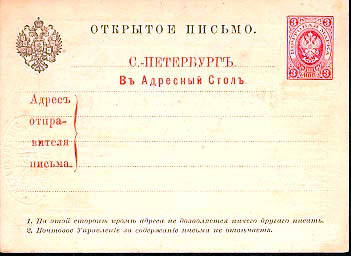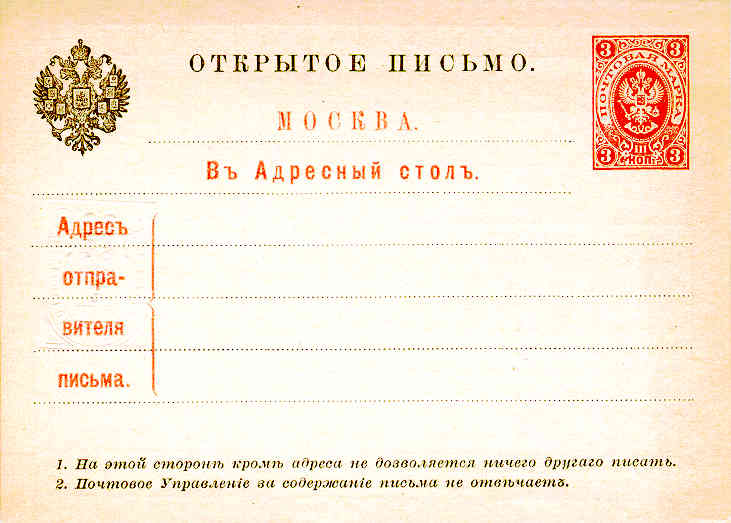



Many of us have seen these cards, some of us collect them, but they can be truly mystifying. The Higgins & Gage catalog does a very poor job of classifying them and ignores any subtle differences. These cards are not rare or even scarce, although they are not as common as many other postal emissions from the period.
All we wish to do in this short article is to make the collector aware of them, that is unless it also stimulates someone to follow up on this topic. These cards were used in St. Petersburg, Moscow, and Warsaw. However, you only get to see a few examples from St. Petersburg and Moscow. Additionally, we will take a look at some subtle differences on what otherwise appear to be identical cards.
First, we need to understand what these cards were used for. These cards are erroneously called "Change of Address" cards. They were used to obtain information about a person's address within the city rather than submit a "change" to one's personal address.
The police were required to know every person and their whereabouts within their area of responsibility. Registration with the local police was required for all people living in or arriving or departing any location within their jurisdiction. Given this, they were tasked with answering questions about people in their jurisdictions and issuing passports/visas.
We think it is appropriate to mention here the basic differences between passports in Imperial Russia and that of Western countries. In many Western countries, especially the United States, a passport is mandatory if you travel OUTSIDE the country. If you never leave the United States, you never need a passport. In Imperial Russia, passports were mandatory for almost every person, especially for any person desiring to travel INSIDE the country. Passports were not issued to peasants without proof that the person was going to a specific place for a specific purpose. Thus, we see that there is a fundamental difference in the requirements for and use of a passport between Imperial Russia and at least the United States. The same basic plan and procedures remained in place throughout the Soviet era as well.
The Address Bureau, which had access to this repository of information, was located in the same building complex (although not the same building) as the Chief of Police in St. Petersburg and Moscow. In St. Petersburg, the Police Chief's office was located at No. 2 Gorokhovaya Street and the Address Bureau at No. 58 Bol'shaya Sadovaya. The St. Petersburg bureau was open weekdays 9AM-6PM and on holidays 10AM-3PM. In Moscow, the Police Chief's office was located on Tverskoi Blvd. and the Address Bureau at No. 3 Znamenskii Lane. The Moscow bureau was open weekdays 9AM-4PM and on holidays 9AM-1PM. If you wanted to locate a person within St. Petersburg or Moscow, you sent an inquiry to the Address Bureau. In 1914, the cost of looking up an address was 3 kop. This did not include any associated cost by doing so through the post.
To inquire about an address, you could send a single card with a request for which you got a single card in return with the answer to your inquiry. You could send a double card that contained both your request and the reply card for the answer. Thus, there are actually three types of cards that you will encounter.
Information was entered on the reverse of the card and sent to the Address Bureau.
Reverse of card and explanation of information required.
Now let's take a look at some of the cards and think back 100 years or so.
Having now a general idea about these cards, let us look at some of the more subtle differences you can find.